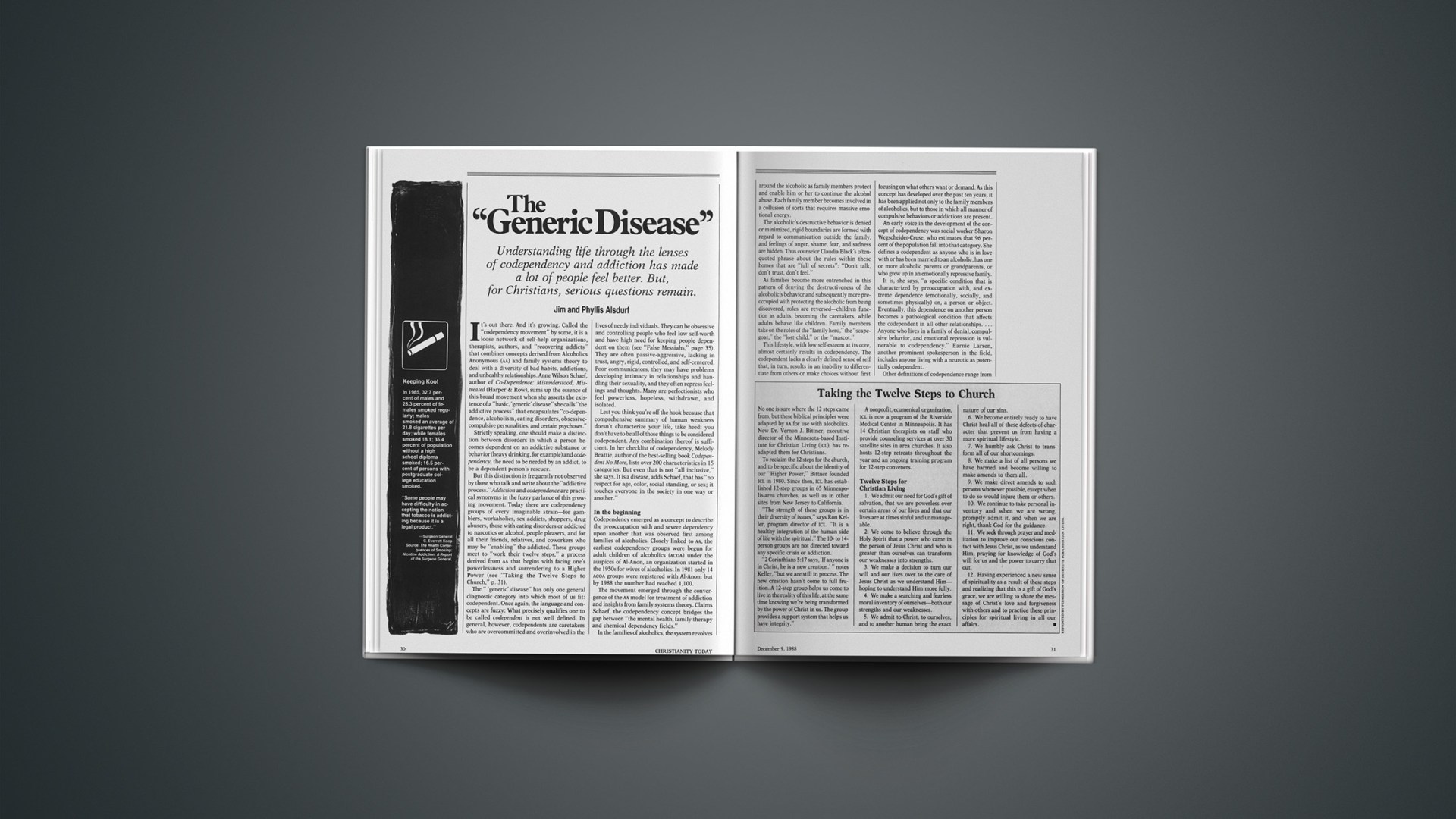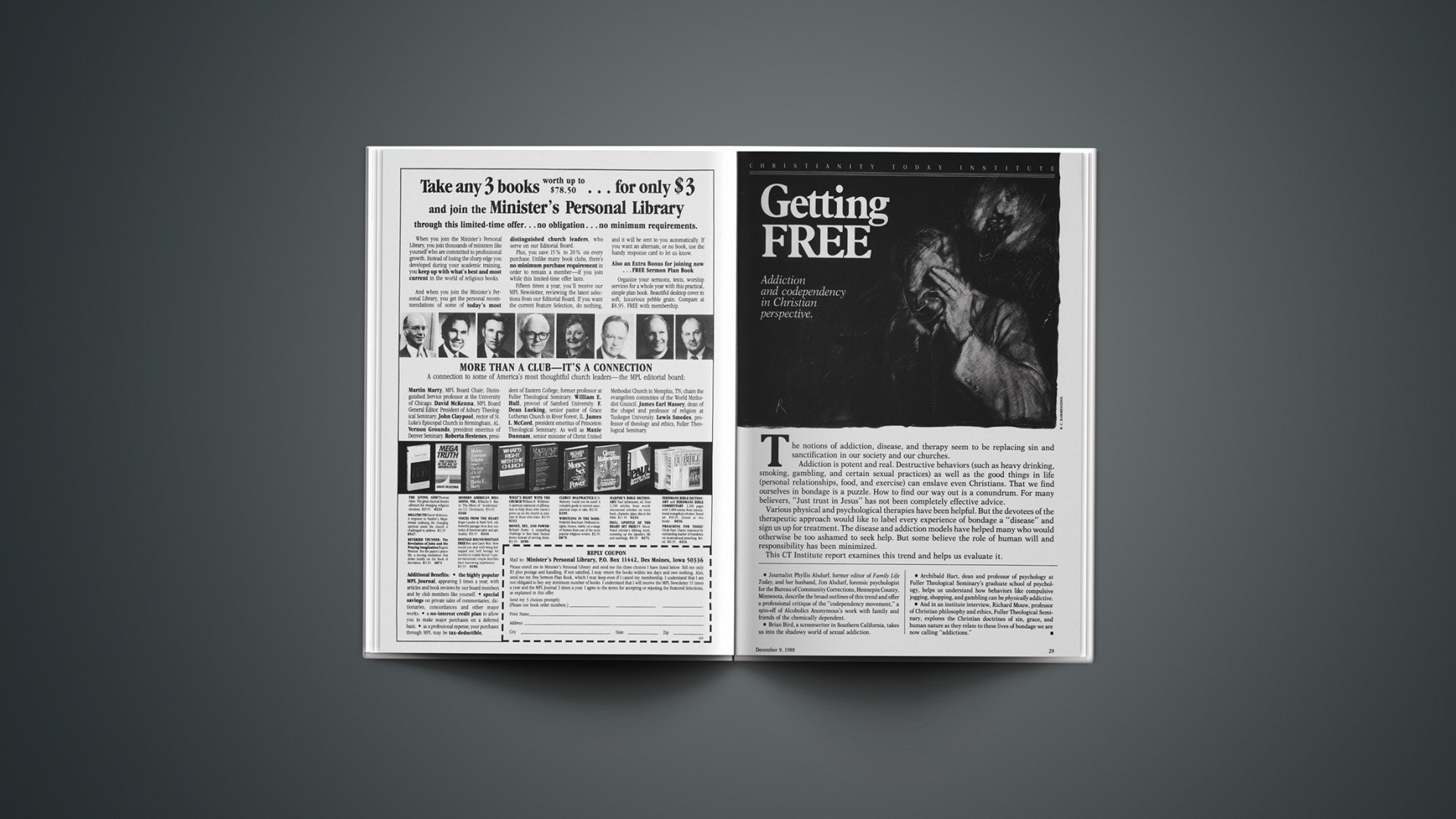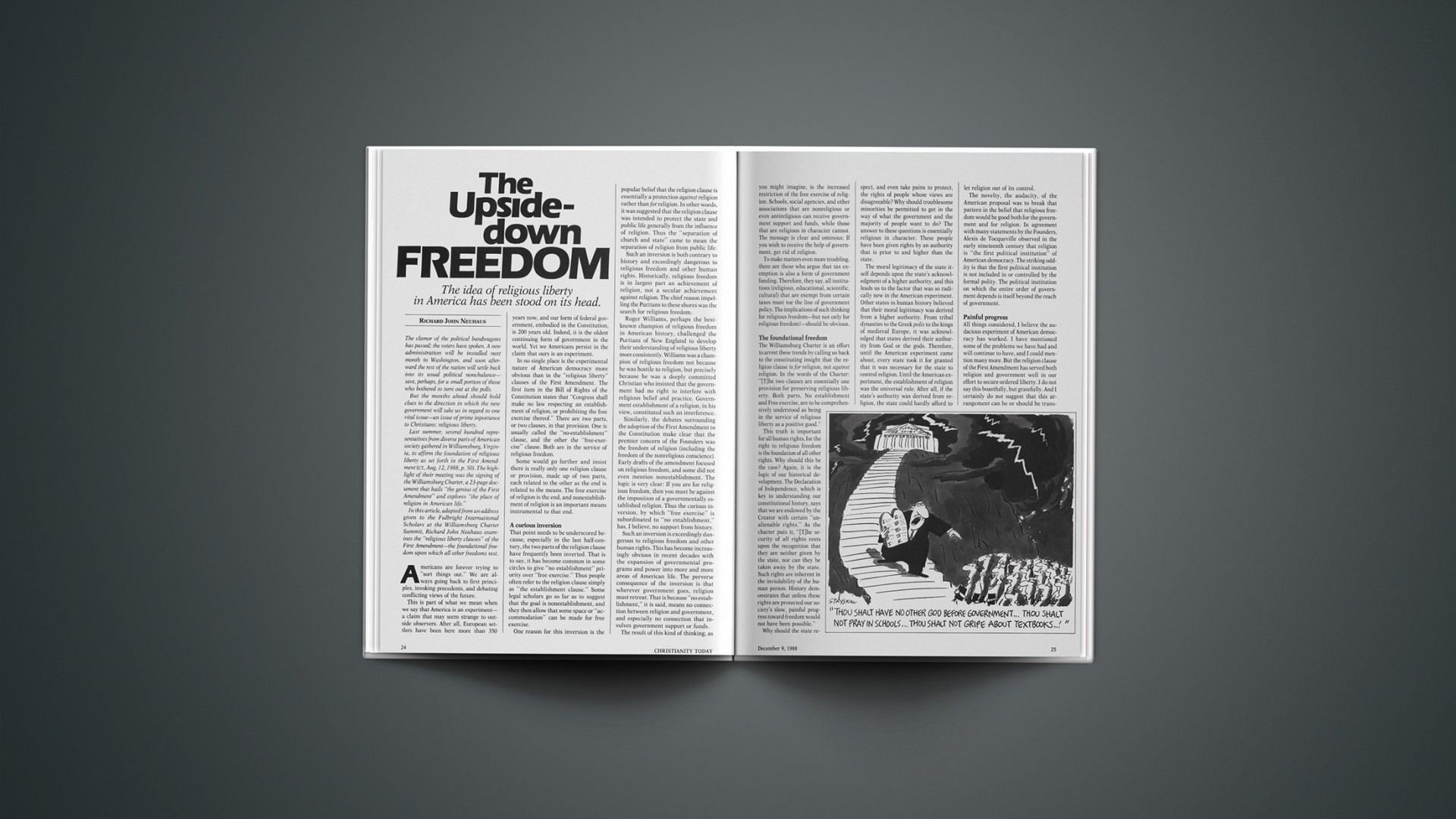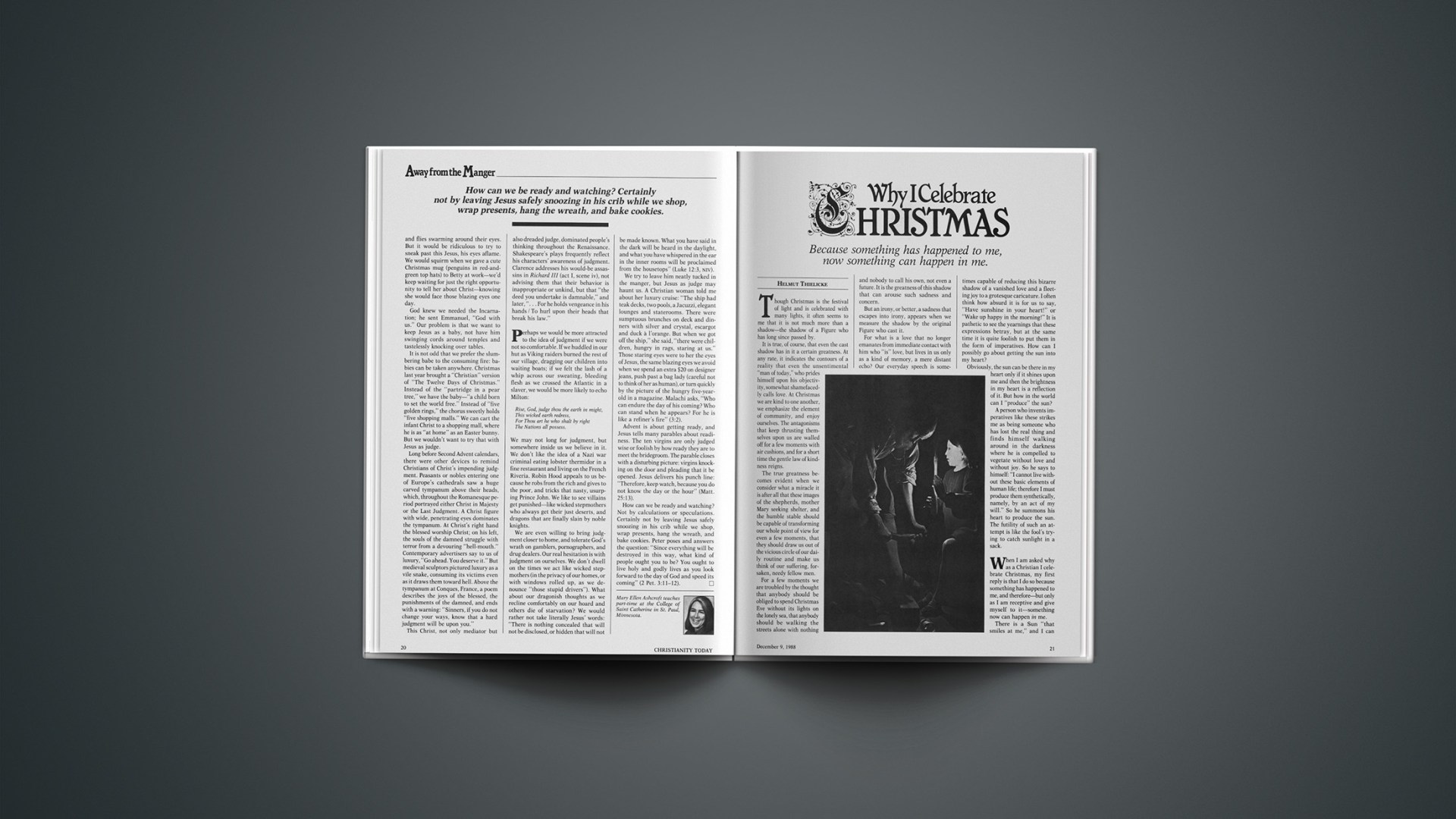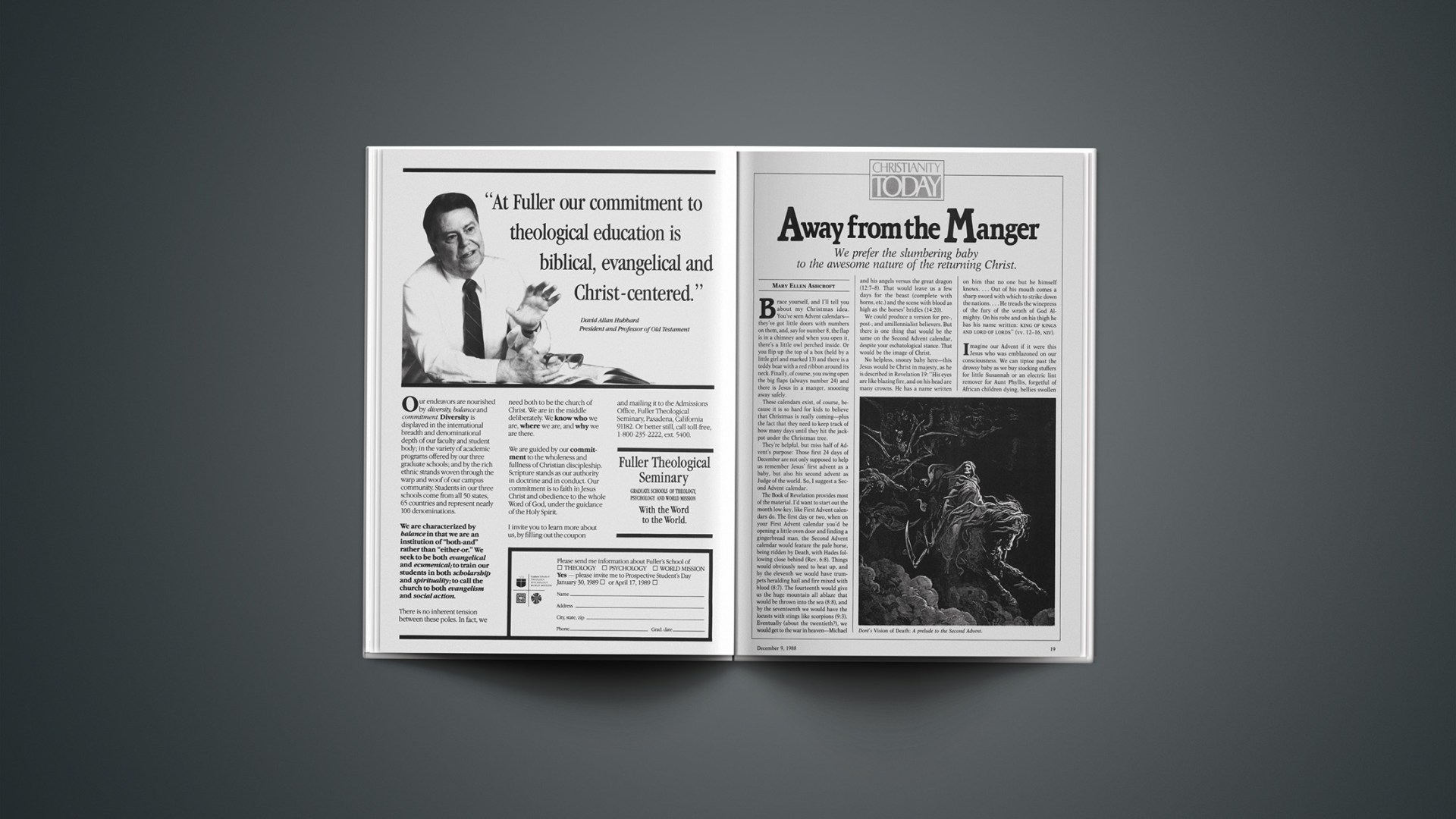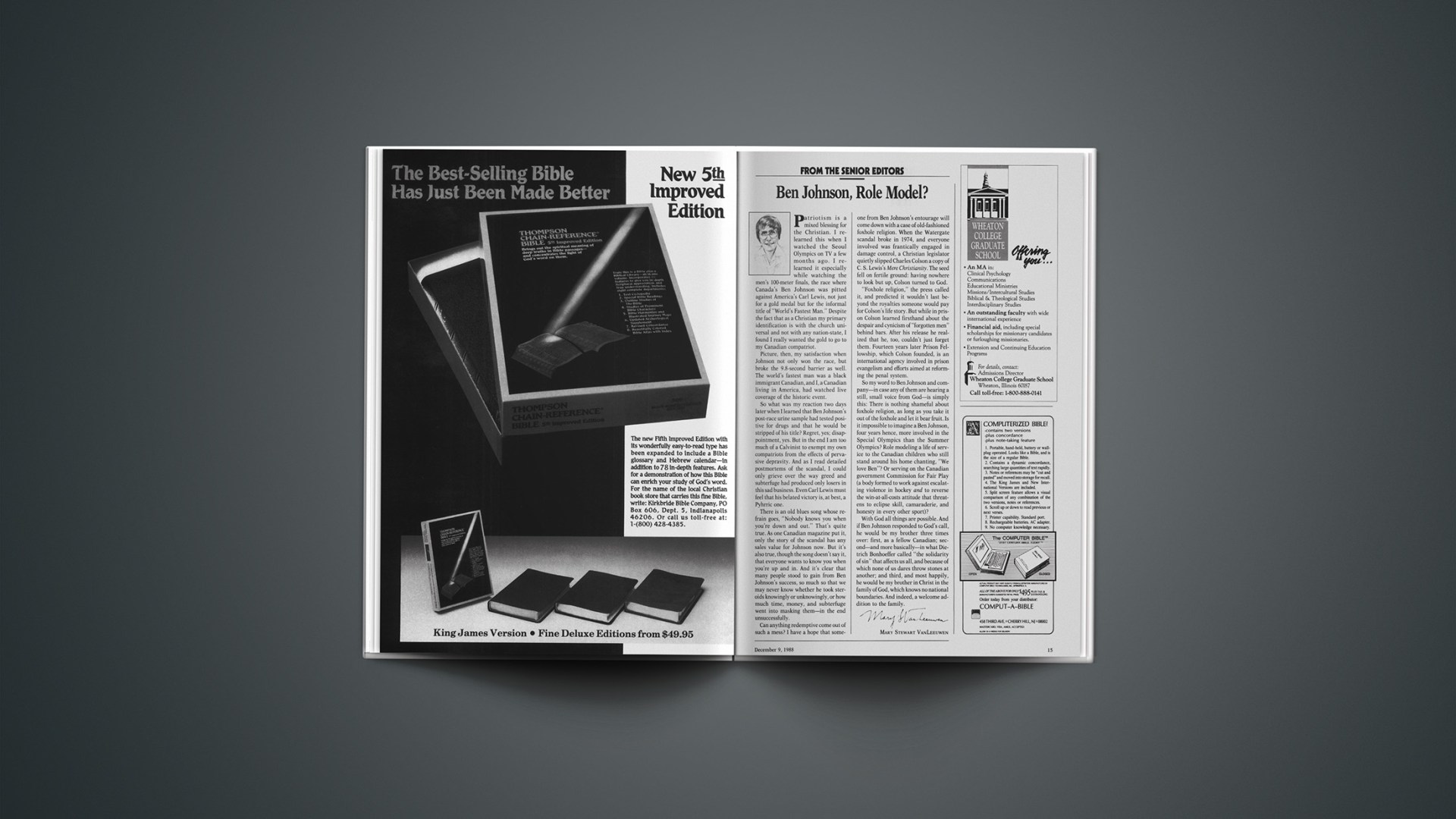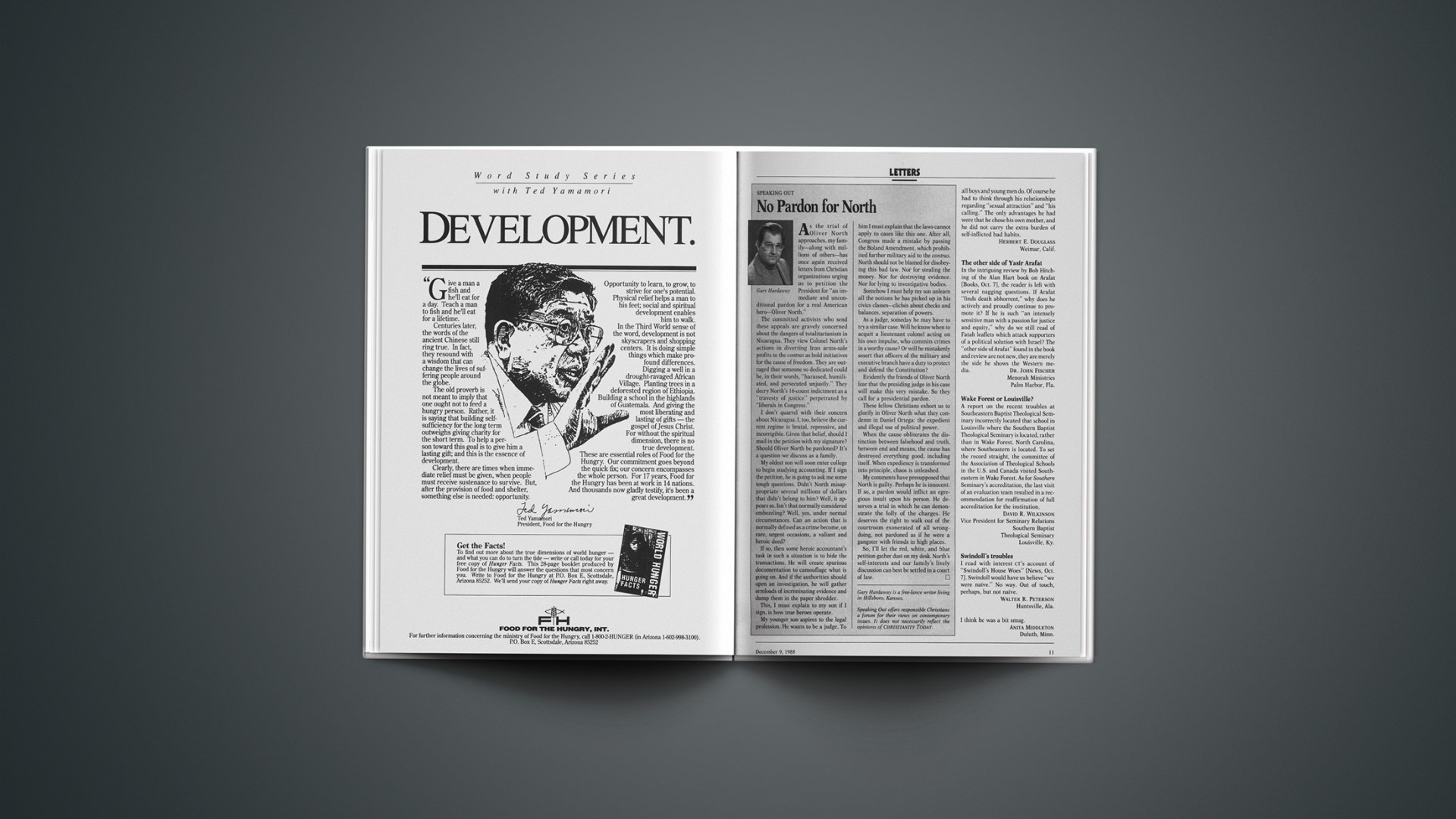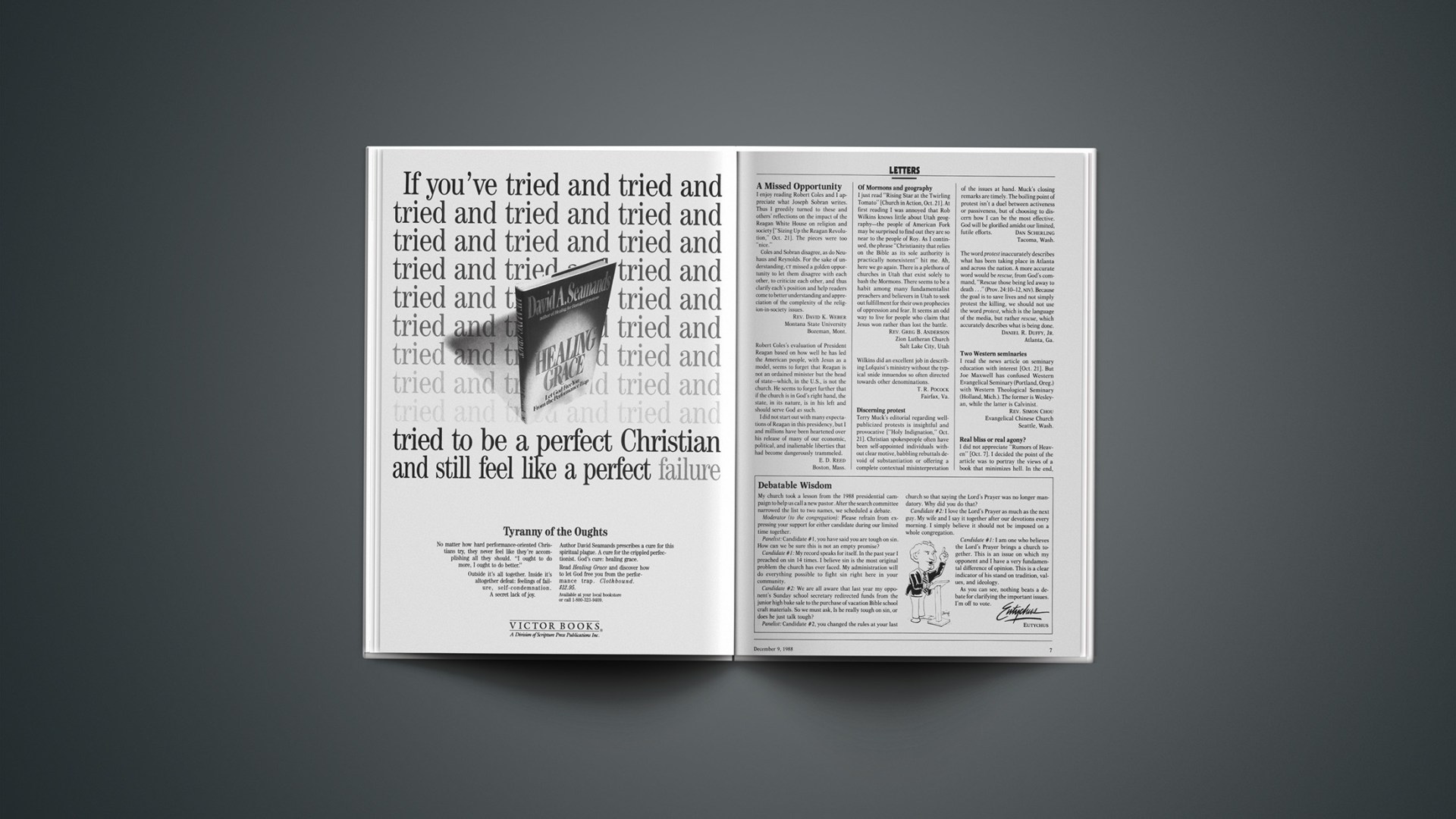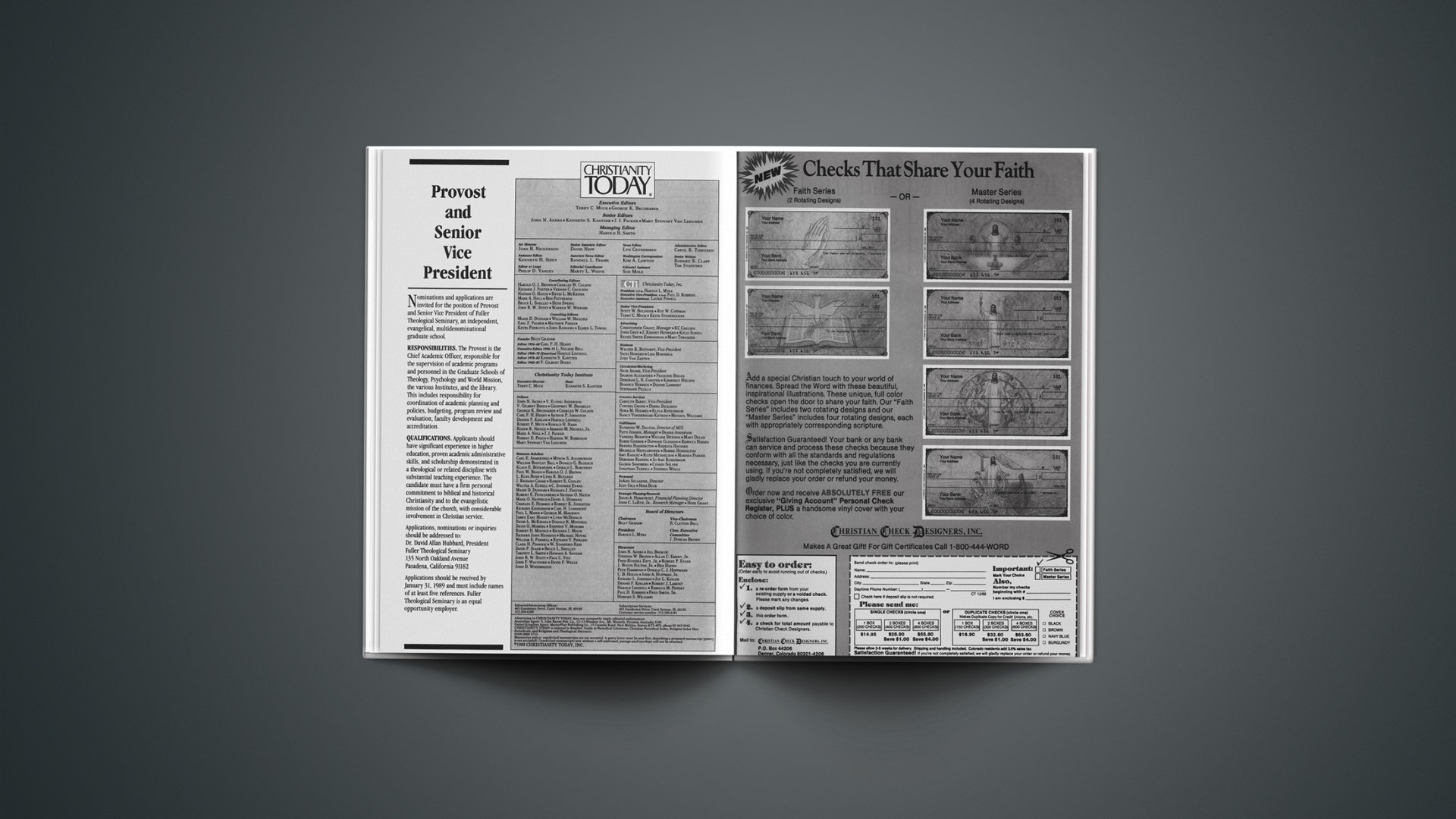Understanding life through the lenses of codependency and addiction has made a lot of people feel better. But, for Christians, serious questions remain.
It’s out there. And it’s growing. Called the “codependency movement” by some, it is a loose network of self-help organizations, therapists, authors, and “recovering addicts” that combines concepts derived from Alcoholics Anonymous (AA) and family systems theory to deal with a diversity of bad habits, addictions, and unhealthy relationships. Anne Wilson Schaef, author of Co-Dependence: Misunderstood, Mistreated (Harper & Row), sums up the essence of this broad movement when she asserts the existence of a “basic, ‘generic’ disease” she calls “the addictive process” that encapsulates “co-dependence, alcoholism, eating disorders, obsessive-compulsive personalities, and certain psychoses.”
Strictly speaking, one should make a distinction between disorders in which a person becomes dependent on an addictive substance or behavior (heavy drinking, for example) and codependency, the need to be needed by an addict, to be a dependent person’s rescuer.
But this distinction is frequently not observed by those who talk and write about the “addictive process.” Addiction and codependence are practical synonyms in the fuzzy parlance of this growing movement. Today there are codependency groups of every imaginable strain—for gamblers, workaholics, sex addicts, shoppers, drug abusers, those with eating disorders or addicted to narcotics or alcohol, people pleasers, and for all their friends, relatives, and coworkers who may be “enabling” the addicted. These groups meet to “work their twelve steps,” a process derived from AA that begins with facing one’s powerlessness and surrendering to a Higher Power (see “Taking the Twelve Steps to Church,” p. 31).
The “ ‘generic’ disease” has only one general diagnostic category into which most of us fit: codependent. Once again, the language and concepts are fuzzy: What precisely qualifies one to be called codependent is not well defined. In general, however, codependents are caretakers who are overcommitted and overinvolved in the lives of needy individuals. They can be obsessive and controlling people who feel low self-worth and have high need for keeping people dependent on them (see “False Messiahs,” page 35). They are often passive-aggressive, lacking in trust, angry, rigid, controlled, and self-centered. Poor communicators, they may have problems developing intimacy in relationships and handling their sexuality, and they often repress feelings and thoughts. Many are perfectionists who feel powerless, hopeless, withdrawn, and isolated.
Lest you think you’re off the hook because that comprehensive summary of human weakness doesn’t characterize your life, take heed: you don’t have to be all of those things to be considered codependent. Any combination thereof is sufficient. In her checklist of codependency, Melody Beattie, author of the best-selling book Codependent No More, lists over 200 characteristics in 15 categories. But even that is not “all inclusive,” she says. It is a disease, adds Schaef, that has “no respect for age, color, social standing, or sex; it touches everyone in the society in one way or another.”
In The Beginning
Codependency emerged as a concept to describe the preoccupation with and severe dependency upon another that was observed first among families of alcoholics. Closely linked to AA, the earliest codependency groups were begun for adult children of alcoholics (ACOA) under the auspices of Al-Anon, an organization started in the 1950s for wives of alcoholics. In 1981 only 14 ACOA groups were registered with Al-Anon; but by 1988 the number had reached 1,100.
The movement emerged through the convergence of the AA model for treatment of addiction and insights from family systems theory. Claims Schaef, the codependency concept bridges the gap between “the mental health, family therapy and chemical dependency fields.”
In the families of alcoholics, the system revolves around the alcoholic as family members protect and enable him or her to continue the alcohol abuse. Each family member becomes involved in a collusion of sorts that requires massive emotional energy.
The alcoholic’s destructive behavior is denied or minimized, rigid boundaries are formed with regard to communication outside the family, and feelings of anger, shame, fear, and sadness are hidden. Thus counselor Claudia Black’s often quoted phrase about the rules within these homes that are “full of secrets”: “Don’t talk, don’t trust, don’t feel.”
As families become more entrenched in this pattern of denying the destructiveness of the alcoholic’s behavior and subsequently more preoccupied with protecting the alcoholic from being discovered, roles are reversed—children function as adults, becoming the caretakers, while adults behave like children. Family members take on the roles of the “family hero,” the “scapegoat,” the “lost child,” or the “mascot.”
This lifestyle, with low self-esteem at its core, almost certainly results in codependency. The codependent lacks a clearly defined sense of self that, in turn, results in an inability to differentiate from others or make choices without first focusing on what others want or demand. As this concept has developed over the past ten years, it has been applied not only to the family members of alcoholics, but to those in which all manner of compulsive behaviors or addictions are present.
An early voice in the development of the concept of codependency was social worker Sharon Wegscheider-Cruse, who estimates that 96 percent of the population fall into that category. She defines a codependent as anyone who is in love with or has been married to an alcoholic, has one or more alcoholic parents or grandparents, or who grew up in an emotionally repressive family.
It is, she says, “a specific condition that is characterized by preoccupation with, and extreme dependence (emotionally, socially, and sometimes physically) on, a person or object. Eventually, this dependence on another person becomes a pathological condition that affects the codependent in all other relationships.… Anyone who lives in a family of denial, compulsive behavior, and emotional repression is vulnerable to codependency.” Earnie Larsen, another prominent spokesperson in the field, includes anyone living with a neurotic as potentially codependent.
Taking The Twelve Steps To Church
No one is sure where the 12 steps came from, but these biblical principles were adapted by AA for use with alcoholics. Now Dr. Vernon J. Bittner, executive director of the Minnesota-based Institute for Christian Living (ICL), has readapted them for Christians.
To reclaim the 12 steps for the church, and to be specific about the identity of our “Higher Power,” Bittner founded ICL in 1980. Since then, ICL has established 12-step groups in 65 Minneapolis-area churches, as well as in other sites from New Jersey to California.
“The strength of these groups is in their diversity of issues,” says Ron Keller, program director of ICL. “It is a healthy integration of the human side of life with the spiritual.” The 10 to 14 person groups are not directed toward any specific crisis or addiction.
“2 Corinthians 5:17 says, ‘If anyone is in Christ, he is a new creation.’ ” notes Keller, “but we are still in process. The new creation hasn’t come to full fruition. A 12-step group helps us come to live in the reality of this life, at the same time knowing we’re being transformed by the power of Christ in us. The group provides a support system that helps us have integrity.”
A nonprofit, ecumenical organization, ICL is now a program of the Riverside Medical Center in Minneapolis. It has 14 Christian therapists on staff who provide counseling services at over 30 satellite sites in area churches. It also hosts 12-step retreats throughout the year and an ongoing training program for 12-step conveners.
Twelve Steps for Christian Living
1. We admit our need for God’s gift of salvation, that we are powerless over certain areas of our lives and that our lives are at times sinful and unmanageable.
2. We come to believe through the Holy Spirit that a power who came in the person of Jesus Christ and who is greater than ourselves can transform our weaknesses into strengths.
3. We make a decision to turn our will and our lives over to the care of Jesus Christ as we understand Him—hoping to understand Him more fully.
4. We make a searching and fearless moral inventory of ourselves—both our strengths and our weaknesses.
5. We admit to Christ, to ourselves, and to another human being the exact nature of our sins.
6. We become entirely ready to have Christ heal all of these defects of character that prevent us from having a more spiritual lifestyle.
7. We humbly ask Christ to transform all of our shortcomings.
8. We make a list of all persons we have harmed and become willing to make amends to them all.
9. We make direct amends to such persons whenever possible, except when to do so would injure them or others.
10. We continue to take personal inventory and when we are wrong, promptly admit it, and when we are right, thank God for the guidance.
11. We seek through prayer and meditation to improve our conscious contact with Jesus Christ, as we understand Him, praying for knowledge of God’s will for us and the power to carry that out.
12. Having experienced a new sense of spirituality as a result of these steps and realizing that this is a gift of God’s grace, we are willing to share the message of Christ’s love and forgiveness with others and to practice these principles for spiritual living in all our affairs.
Other definitions of codependence range from seeing it as a pattern of learned behaviors, feelings, and beliefs that “make life difficult” to “an emotional, psychological, and behavioral condition that develops as a result of an individual’s prolonged exposure to, and practice of, a set of oppressive rules.” Physician Charles Whitfield asserts that codependency affects individuals, families, communities, businesses, states, and countries. Schaef takes that all-encompassing definition a step further to propose that society itself is an “addictive system.” She concludes, “When we talk about the addictive process, we are talking about civilization as we know it.”
Oversimplified Complexity
Critics point out that one danger of the blanket application of codependency is that serious psychological disorders are easily misdiagnosed. Minneapolis psychiatrist Carl Malmquist charges that the concept of codependency “doesn’t do justice to the complexity of problems that are often present. I think it is applied too widely, too indiscriminately. Many of the people using it have not had exposure to other kinds of training that would fit it into the broader realm of the interpersonal school of psychotherapy.… I have seen people who have been treated that way, gotten some temporary help and then slipped into much more subtle patterns of what I would call masochistic behavior.”
It is not that codependency is erroneous, he continues, but that it fails to encompass the complexity of human nature. “Someone may seem to be addicted to food, but I want to get in and see what’s the source of this eating disorder. Some bulimics are depressed; some are schizophrenic. Diagnostically we want to be very clear on that. Just to say they are all addictive people doesn’t tell me enough. It’s not sufficient.”
This oversimplification can be a particular problem, notes Minneapolis child psychiatrist Richard Miner, in the parent-child relationship when the legitimate dependency needs of children and adolescents are viewed as “manipulative or destructive.” The parent may end up seeing “all dependency behavior as pathological when it is simply nurturance-seeking behavior on the child’s part,” says Miner.
Because this model developed through work with adults, specifically adults from alcoholic families, it is especially weak in giving consideration to the developmental needs of children or adolescents for healthy dependency. The model also fails to acknowledge the full range of individual psychopathology, states Miner. Unreasonable expectations for change often result.
Another psychologist cited two cases in which juveniles were inappropriately identified as codependent when in fact one was manic-depressive and the other schizophrenic. Each was told to leave home by parents who refused to have a “codependent relationship” with their child.
Psychiatrist Timmen L. Cermak has attempted to qualify the wide-reaching application of the codependency label by advocating codependence as both a “legitimate psychological concept and an important human disorder.” In Diagnosing and Treating Co-Dependence (Johnson Institute Books), Cermak notes that codependency has not provoked much interest within the mental health community because there exist no “generally accepted definitions” of codependency. Most definitions of codependency have been “anecdotal or metaphoric and neither … stands up well under scientific scrutiny.”
Calling for a definition at a level of sophistication at least equal to standards set forth for diagnosing other psychiatric disorders, Cermak faults the “apparent ubiquity” with which codependence has been applied. He rejects the broad definition of those who have called codependence “a condition of the twentieth century.”
Cermak does recognize, however, that when such traits become “enduring patterns of perceiving, relating to, and thinking about the environment and oneself,” they result in a personality disorder. Codependency is at that point a definable, clinical entity that must be taken seriously, he contends. While we may all at various points act codependently, to argue that almost everyone is codependent, Cermak says, discredits the useful application of this concept by oversimplification.
The Ultimate Addiction
For Christians, the all-inclusive definition of codependency may sound like another way of identifying the universal human problem of sin. Such a view is held by J. Keith Miller, who postulates that addiction is endemic to the human condition; it is just another word for sin. Specific sinful acts are not what constitute Sin (with a capital S), he claims in his book Sin, the Ultimate Deadly Addiction (Harper & Row), but are only “symptoms of a basic and all-encompassing self-centeredness, an attitude that colors every relationship, including our relationship with God. It is this deeper, more central attitude that leads to all the thoughts and actions we call sins. And it is the underlying attitude that is Sin.… Sin, in this view, is about our apparent inability to say no to our need to control people, places, and things in order to implement our self-centered desires.”
The “blinding self-absorption called Sin,” Miller continues, is the same underlying dynamic at work in the life of the chemical addict. “Sin is the universal addiction to self that develops when individuals put themselves in the center of their personal world in a way that leads to abuse of others and self. Sin causes sinners to seek instant gratification, to be first, and to get more than their share—now.”
While even secular leaders in the movement agree that embracing one’s spirituality is fundamental to the task of getting “unhooked” from codependency, they generally have a less than charitable view of the church and traditional Christianity. Schaef, for instance, sees the family, school, and church as equally guilty of “cultural co-dependence training.” She charges: “They teach us to think what we are told to think, feel what we are told to feel, see what we are told to see and know what we are told to know.… In training us to be ‘nice,’ the church actively trains us to be co-dependents.”
In Colorado Springs: A Church Reaches Out
Twice a year. First Presbyterian Church of Colorado Springs offers an eight-week workshop entitled “Freedom from Codependency.” Started as a ministry to adult children of alcoholics, the workshop is now open to anyone struggling with a relational dysfunction.
Each year attendance has swelled. What began as a group of 45 in 1984 has mushroomed within four years to attendance of over 600. This year registration was limited to 550 and filled to capacity.
The workshop is the brainchild of Dennis Chambon, a local businessman and a member of First Presbyterian who has been in recovery from chemical dependency for several years. It meets for two and one-half hours each session and is designed to help participants face their own codependency. Drawing upon his experience as a counselor at a local chemical dependency treatment center, Chambon teamed up with Marilyn LeVan, associate for singles ministry at the church, to begin a small support group for adult children of alcoholics.
Chambon and LeVan make it clear that the workshop is not for onlookers who are merely interested in learning about codependency. “We talk about what codependency is and tell them they are not there to fix anyone else,” says LeVan. “Each person is there because they’ve got codependency. We hope it will lead them into a 12-step group when the eight weeks are done.”
Through the use of movies, lectures, role playing, and personal testimonies, the workshop explores codependency as an addiction, its impact on family members and other relationships, and points the way to recovery.
Seeking spiritual answers
LeVan and Chambon do not hesitate to share the importance of their relationship with Christ as they have worked through their own problems with codependency. But they make an effort not to be “offensively Christian” inasmuch as the workshop attracts most of its members from outside the church.
“We’ve got a way of communicating that slips into people’s lives,” Chambon says. “We know their defenses and try to come at it from another angle. A lot of people are beginning to understand they have problems in relationships and are seeking spiritual answers.”
LeVan concurs: “Our approach is to focus first on people’s powerlessness. But when it fits and is appropriate, we are free to share who our Higher Power is. Were there to help people understand how powerless they are so that they are ready to turn to God for help.”
Church growth and staff growth
What has the impact of this workshop been for the church? Executive minister Jim Smith is one of three pastors on the staff who have completed the workshop, Dennis Chambon and he praises it on several levels. “Personally, it was very good for me to look at my upbringing, to begin to discover things about myself,” he says. “It has stimulated real growth in my own life.”
“ ‘Freedom from Codependency’ has been a tremendous outreach into the community,” he says. “It’s evangelism.” But the workshop has also been attended by church members. “People who have been Christians for 20 or 30 years are finding that examining the past is freeing them from dysfunctional patterns of relating,” Smith notes. “It is a workshop where lives are changed. Here is a tool that the Lord is using to bring a newness, an intimacy in their relationship with Christ.”
Smith also refers many of those who come to him for counseling through the workshop. “Here we have an opportunity to plug people into an ongoing ministry. I now see their lives in a new perspective, through the lens of codependency.”
LeVan acknowledges that a number of people have joined the church whose initial exposure to First Presbyterian was through the workshop. “Perhaps more important,” she says, “are the staff members and professional people from the church who have gone through the program and found it to affect their ministry in significant ways. The more into recovery they are from their own codependency, the less likely they will relate to people in a care-taking rather than care-giving manner.”
Do Chambon and LeVan see people latching onto the codependency movement itself as a panacea for all of life’s problems? “I trust God in the process,” says LeVan. “If people are falling into false gods, including 12-step groups, that too will fail. I trust that God will bring each one of us to where we need to be. God weeds out our false gods until we find out who he really is.”
For the future, LeVan and Chambon have a dream of training church leadership. “Every single minister, counselor or psychiatrist needs it for themselves in order to do what God has called them to do even better,” says LeVan, articulating her vision. “But the only way to train others is for them first to experience it themselves, for them to deal with their own insecurities. Then it will change lives.”
By Jim and Phyllis Alsdurf.
Christian author Melody Beattie disagrees: “Codependency is learned behaviors that are passed on from one generation to another. Certainly if you do a biblical study you see the importance of family of origin, the sins of the fathers being passed on. And the goal of recovery and of Christianity are the same: healthy human behaviors that work. Certain behaviors have certain consequences; there are certain laws. Recovery is about learning those laws. Hating yourself doesn’t work. Taking care of others and not yourself doesn’t work.”
Colorado Springs psychologist Joseph Hammock agrees that some scriptural truths are echoed in the message of codependency, but feels that its proponents don’t go far enough. “Codependency says that human beings have problems because we don’t exist in the right relationships with each other—we either get too close, or enmeshed, or we are too far away, and we become disengaged,” he says. “But if we become disengaged from people, it’s because we’re enmeshed with something else—because all human beings are made with a need to become involved, to have intimacy.
“That is close to what the Bible says, in that we need a relationship with God to be all that we can be, to be in balance. The world is full of people who are trying to fill that ‘God-shaped vacuum’ with one thing or another, and hence compulsions arise. The cure for codependency is that one moves into a right relationship with God, and as a result—in part, both as a cause and an effect—into right relationships with people in your life, with yourself, and with your natural environment.”
Hammock cautions, however, that while codependency experts have the right idea about the fundamental problem of humanity, “they are missing the key ingredient as to what the solution is. Leaders of codependency groups, even those who are Christian, don’t emphasize that fact, often saying they are trying to appeal to a broad variety of people. But at a certain point, if you go too far in trying to reach the lowest common denominator, you give away too much of what in the end is required to solve the problem.”
Taking The Morality Out
Another critical issue Christians face in assessing the codependency/addiction movement is the concept of moral responsibility. Writing about sexual addiction in his book Out of the Shadows (CompCare Publishers), psychologist Patrick Carnes advances the popular perspective that the sexual addict has “no choice. The addiction is in charge.” Similarly, in Fat Is a Family Affair (Harper & Row/Hazelden), psychologist Judi Hollis says that “the addictive model takes morality out of eating disorders.”
What is being crafted in this deterministic outlook is a view of the individual as having no control over choices because of the presence of an insidious disease/addiction/codependency. The irony, of course, is that the addict is expected to make the choice to admit that he or she is powerless to control the addiction and to place his or her faith in a Higher Power.
Psychiatrist Gerald May specifically addressed the issue of addiction and moral responsibility in a telephone interview from his office in Washington, D.C. “We are absolutely responsible,” he asserted, “and our addictive patterns don’t change that.” He defines codependency as “one person’s addictive patterns aligning themselves with another’s or others’ so that there is some degree of systemic collusion or addictive pattern.”
May, the author of Grace and Addiction (Harper & Row), makes the following distinction concerning the neurological, spiritual, and psychological factors in addiction: “If you look at the addictive pattern in terms of nerve cell interaction, those patterns are something we can’t change. But, how and when we act or behave in response to those patterns, we are responsible for such acts. There is always choice.” While the existence “of the thing itself [compulsion or obsession] is not something we can control, we do control how we respond to it. There is always a level of freedom to that, and that’s the bind, and that’s why grace is so essential.”
Acknowledging that it is “a bit devastating” to recognize the “global nature of how addicted we are,” May rejects the notion that addiction and disease are synonymous. “If you’re looking at it from the standpoint of understanding what really goes on with the basic nature of human beings and the addictive process,” he said, “then you don’t want to be thinking in terms of disease, abnormality, or anything like that. It’s just theological anthropology, just the way things are.”
The Disease Myth
Without a doubt, one of the most disconcerting aspects of the codependency/addiction movement is the freedom with which the term disease is applied to every imaginable compulsion. Building on the assumption that alcoholism is a disease, spokespersons in the field are often cavalier in applying this concept to a host of other behaviors. But because codependency fails to meet even the physiological, genetic, and metabolic criteria that might qualify alcoholism as a disease, codependency as a disease is all the more called into question.
“You have a disease when you are not at ‘ease,’ ” claims Judi Hollis. “Alcoholism is a disease and so are eating disorders.” Arguing for the concept of a “basic disease underlying all of the addictions and addiction-related diseases,” Anne Schaef says, “Everyone who works with, lives with, or is around an alcoholic (or a person actively in an addictive process) is by definition a co-dependent and a practicing co-dependent. This includes therapists, counselors, ministers, colleagues, and the family.… These people are not just being affected; they are also slipping into their disease and losing their own sobriety.”
Researchers P. Nathan and A. Skinstad note that the disease mode “has been no more productive of positive therapy outcomes than have any of the countless, unidimensional views of alcoholism that coexist with it.” In his controversial new study on the subject, internationally recognized addictions expert Herbert Fingarette argues that the disease concept of alcoholism stands on a precarious foundation, at best. It is a simplistic, outdated, and “arcane” concept, he charges in Heavy Drinking: the Myth of Alcoholism as a Disease (University of California Press), a book that is “bitterly resented in alcoholism circles,” he said in a phone interview. Such a view rests not on scientific or psychological support but largely on the powerful influence of certain economic concerns, says Fingarette (referring perhaps to the large degree to which many alcoholism treatment programs depend on patients’ medical insurance for income).
Fingarette sees the disease model as “a harmful notion” because it removes the problem from the realm of the human, “where humans are acting responsibly, even though unwisely, destructively, foolishly and there ascribing it to some simple, though unknown, physical process or breakdown in a piece of inner machinery.” Such a shift in conceptualizing the matter “distorts the nature of the problem and makes it into a technical thing where experts are to be called on.”
“It’s really a human problem, and it comes down to that when you push people to the wall,” he stated. “They say, ‘Well it’s not just physical, but a psychological and spiritual problem, a cultural problem. That’s the kind of disease it is.’ What they are doing is using medical-sounding language to talk about these matters, which disguises the fact that they don’t have a medical account of it. They are constantly withdrawing the person’s attention from what is the person’s dilemma and trying to turn it over to medical experts, when in fact the evidence is against it.” The disease model “undermines a person’s resolution to handle this problem responsibly,” he continued. “And it also insidiously incites more of the behavior.… Objectively speaking, it’s an encouragement to continue if you let people know they are not responsible, that they will be excused for it.”
False Messiahs
Four years ago Carmen Berry burned out. A social worker who generally devoted six days a week to her job, she volunteered at her church, served on committees, and saw clients before the Sunday morning and evening services. She was indispensable. Until she burned out. “My relationships were unsatisfying,” Berry recalls, “I was absolutely exhausted. I was alienated from other people.”
Physically sick and emotionally spent, Berry took a year off—quit her job, stopped going to church, and began a spiritual journey of prayer and therapy. “God really met me in that year,” she says. “My relationship with God was the basis of my recovery.”
Out of that experience and her work with numerous driven clients emerged Berry’s concept of the “Messiah Trap,” which she outlines in her book When Helping You Is Hurting Me: Escaping the Messiah Trap (Harper & Row). “Messiahs” are so busy taking care of other people that they don’t take care of themselves, she says. “Messiahs neglect themselves because they feel that they are supposed to sacrifice their own well-being for the sake of others. This is the Messiah definition of love.… [It] is an odd combination of feeling grandiose yet worthless, of being needed and yet abandoned, of playing God while groveling.”
Berry feels that the church has contributed to the problem. “In my background the church overemphasized helping others to the neglect of one’s own growth,” she said in a phone interview from Los Angeles. “There is a heavy emphasis on helping other people without struggling with what it means to really love people. This attitude is almost considered a virtue in the Christian subculture. Rarely have I heard a sermon that perhaps you should go home and take time for your family. The attitude is that we are basically selfish and need to be pushed into more service.”
Judging by the frequent calls she gets from Christians who are “absolutely desperate—marriages falling apart, leaving the ministry,” Berry sees the problem as a serious one. She cautions that in any healthy, loving relationship “there are disciplines that go with the relationships.” Self-sacrifice and submission are part of genuine love, she notes. Messiahs, however, are “very narcissistic.” By promoting themselves as superhuman beings, they avoid real intimacy: “I’m helping you, but I’m also using you for status, for money, or to gain power.”
“My faith and trust in God are significantly deeper now,” Berry notes. “I used to struggle with evil in the world. Here I was doing an enormous amount, and I didn’t see God doing anything. I had a skewed attitude.
“Now I have this wonderful sense that he is active and in control, not that he is trying to keep up with me. I have a sense of peace I never had before. Before I was too busy for God to see him.”
What are some precautions, some safeguards against becoming a Messiah? “You need to be connected to your internal signals,” she says. “If you are helping in such a way that you feel angry, exhausted, and guilty—and that no matter what you do you aren’t doing enough—then you’re probably falling into the Messiah Trap.”
Balance is the key for Berry. “Jesus illustrated in a balanced way how to minister,” she concludes. “He took time to pray, time for his personal relationships. He didn’t respond to every need.… He knew when to say no.”
By Jim and Phyllis Alsdurf.
No Pigeonholes
Fingarette also dismisses the view that if “it isn’t a disease then it’s a matter of just will or choice.” “We have to get rid of the very simplistic notion that it’s simply a matter of will or sin and replace it with the sense that gradually, over the years, whatever it may be—sex, drinking, adventure, money, or power—with some people it becomes more and more central to them.… Gradually it becomes the central activity in a person’s whole way of life. It is true for anyone, unrelated to disease or symptoms, that if your whole life is shaped in such a way, it is very difficult for anyone to make radical changes even if they think rationally they should.”
The concept of a person’s way of life is “purposely broad,” he said, because just to look at the problem of addiction as primarily physical or psychological is inadequate. An “overarchingconcept” is needed that emphasizes “the entire being.” “It’s a human problem, which involves the physical, mental, cultural, and so forth,” said Fingarette. “We can’t put it in one pigeonhole or another. It will vary from person to person. I don’t believe that one disease with one cause and one process will explain it.”
The acknowledgement of the spiritual dimension within alcoholism treatment and codependency is “a move in the right direction,” he said. “Although AA allows you to mean anything you want by it, it’s a gesture in that direction. But it doesn’t give any real guidance.”
The church, on the other hand, should be nothing but “fundamentally opposed” to the disease concept, contended Fingarette. “I just don’t understand why any churches would go for the disease idea, except insofar as they are taken by the notion that we have to be enlightened and that seems to be the enlightened view. The disease approach denies the spiritual dimension of the whole thing. People in the church may be afraid to take a different stand because it will be labeled antiscientific, antimodern, or old-fashioned. I think that’s all misguided.”
Help For The Sexually Addicted
It was time to come clean. Twenty-five-year-old “James” had made a searching moral inventory of his life. He could no longer live the lie. As his young wife, “Sarah,” the mother of his two children, sat numb, James spelled out forher a story of secret betrayal and bondage that even the most exploitative checkout-stand tabloids would have found difficult to print.
He started with foggy memories of being molested by a male schoolteacher at age nine. And he ended with a tearful account of stalking two adolescent girls and trying to lure them into his car in order to seduce them.
In between, James described a complex web of symptoms of his own sexual compulsivity: fascination with hard-corepornography for as long as he could remember; habitual masturbation; dozens of sexual encounters as a teenager with girls, other boys, older women; anonymous sodomy with other men inside X-rated “peepshow” booths; “binging” on prostitutes during work trips; seducing a church teenager while serving as a youth sponsor; and the syphilis and herpes he had brought home to the marriage bed.
“I was the consummate Dr. Jekyll and Mr. Hyde,” James would recall a year later, from the small, Colorado town in which he lives. “I had a good job, expense account, company car, house, and was active in the local church. Two years later, I was bankrupt, the furniture was gone, the house was in foreclosure. During those months, I spent $20,000 on my habit … grocery money, shoe money for the kids.
“It got so bad at one point I had to stop changing my little girl’s diapers because of the thoughts that would come into my head,” he confesses. “I didn’t care who it was with. I just had to have my fix.”
Ten million “sexaholics”
James is an example of what a growing number of psychologists are calling the “compulsive sexual addict.” Or, in the vernacular of one of the 12-step recovery groups that has emerged in the last two decades, a “sexaholic.”
He is one of an estimated 10 millionplus Americans suffering from a personality disorder that is sending many psychologists back to school for further training, and leaving sociologists shaking their heads in disbelief.
In the promiscuous shadow of the sixties and seventies, the psychological world has been slow to view sexual compulsion as an addiction as serious and destructive as alcoholism or other chemical dependencies. Unlike the pathology of physical addiction to drug or drink, which for decades has been considered a medical illness, the victims of sexual and other behavioral addictions (such as compulsive eating and gambling) have struggled to find much professional sympathy.
Sociologists, on one hand, continue to regard sex as a relative human experience, in which notions of normality drift with the ebb and flow of culture. Some argue that stigmatizing sex outside of marriage as mental illness is a dangerous precedent—a legitimizing of the Judeo-Christian view of sexual sin as a pathology needing treatment by professional psychology. They point to Scandinavian countries and other cultures, where many practice recreational sex apparently free of guilt, as evidence that deviations from strict monogamy occur naturally.
“We sociologists take a real jaundiced view of the degree to which some psychotherapists have pathologized the world,” says Martin Levine, associate professor of sociology at Bloomfield College in New Jersey, who presented a paper entitled “The Myth of Sexual Compulsivity” to the American Psychological Association Convention in 1986.
“There are people who talk now about being addicted to jogging—where’s it all going to stop? The Christian fundamentalist camp, both politically and through its ministry, is now using the sexual-compulsion model in its antipornography crusade. Some are even using the 12 steps to deal with members of their congregations they call sinners,” Levine adds.
Psychotherapists, on the other hand, are trying to make up for decades of indifference. Picture the multicolored “Rubik’s Cube,” and you have some idea of the complex matrix sexual behavior has become for researchers.
Not waiting for science
Meanwhile, sexual addicts have not waited for the behavioral sciences to catch up. In the mid-1970s, a recovering alcoholic on the East coast began experimenting with the 12 steps—pioneered decades earlier by Alcoholics Anonymous (AA)—for his own sexual compulsion. Soon he had formed what is believed to be the first support group for sexual addicts, Love and Sex Addicts Anonymous. At the same time, similar movements were taking shape in Minneapolis and Southern California under the names Sex Addicts Anonymous and Sexaholics Anonymous.
More recently, another program, Sexual Compulsives Anonymous, was started in Los Angeles by a group of homosexuals. They were uncomfortable with the “no sex outside of heterosexual marriage” tenor and Judeo-Christian concept of God found in AA’S traditional 12-step program.
Leaders of the four organizations estimate there are hundreds of meetings reaching thousands of sexual addicts each week around the country. In Los Angeles, for instance, there are now 30 meetings of SA, SAA, SCA or LSAA held each week, drawing more than a thousand participants. This is not particularly large when compared to the 2,000 AA meetings taking place in Los Angeles. However, leaders point out the sex-recovery movement is growing far faster than did AA during its infancy.
The 12 steps of AA and those for most of the sexual rehabilitation programs are virtually the same. They require a willingness to acknowledge powerlessness over sexual compulsion, submission to God, or “God as we understand Him,” and the need to make amends with others who have been harmed by the behavior.
The bible of sexual sobriety
One of the relatively few psychologists who have specialized in the field of sexual addiction is Minneapolis’s Patrick Carnes. In 1978 Carnes established the nation’s first treatment center for sexual dependency. His Golden Valley Health Center integrates the 12-step program in an inpatient program that includes group therapy and family counseling.
Bucking professional trends, Carnes made his treatment ideas public with the release of a book in 1983, which has become a sort of bible for many of the sexual-sobriety groups. Out of the Shadows: Understanding Sexual Addiction (CompCare Publications), says Carnes, grew out of his experiences treating a group of sex offenders in prison.
In his book, Carnes describes the theory of “addictive progression,” in which some people with compulsive tendencies climb the ladder of sexual deviation a rung at a time. Starting, for instance, with pornography, the subject then seeks out more and more taboo forms of sexual experience, sometimes crossing the line from legal to illegal sexual behavior.
In the introduction to his book, Carnes describes the moment when one realizes he or she is a sexual addict: “When you have to tell yet another lie which you almost believe yourself … when the money you have spent on the last prostitute equals the amount for the new shoes your child needs … when your teenage son finds your pornography … when you see a person on the street you had been sexual with in a restroom … when you make business travel decisions on the basis of the affair you are having … when you have to leave your job because of a sexual entanglement … when you cringe inside because your friends are laughing at a flasher joke, and you are one.…”
Many in his field initially criticized Carnes’s book as “pseudoscience.” But as more and more sexual addicts seek help, a growing number of therapists are seeing the book as an important foray into a new frontier.
And for James of Colorado, Out of the Shadows was his last hope. “I went to a psychologist for help, and he tried to tell me I didn’t have a problem,” James remembers. “In a small town you don’t have a lot of choices, so Carnes’s book has been my only source of help.”
By Brian Bird, a journalist and screenwriter living in Southern California.
Flight From Loneliness
It is important to note that something need not qualify as a disease in order for it to be a legitimate and significant human concern. Certainly the mere popularity of the codependency movement indicates that it strikes an important chord with countless individuals who feel trapped in unsatisfying patterns of relating to others.
One cannot help wondering, however, if the prominent voices within the codependency movement who tell us that almost everyone is codependent are merely describing human nature. Could codependence be that part of the human condition in which the search for connectedness and the avoidance of loneliness have gone awry? Codependency may well represent desperate attempts to avoid aloneness. It reflects the struggle of humankind from the Garden onward not to be alone. Certainly this search is more a statement of what it means to be human than a symptom of some medical condition.
The ontological reality of being human is that in any attempt to avoid loneliness we may give away too much of ourselves—to a chemical substance or to an unhealthy relationship—and so experience a new form of loneliness. Regardless of its flaws, the codependency movement beckons us to discover the balance of healthy interdependence. Along a continuum, with consuming codependence on one end and reclusiveness at the other, we are challenged to find the point of healthy balance where we will be in right relationship with others.
Although many Christians will find much that rings true in the addiction and codependency literature, one major hurdle remains: the invitation to narcissism. Statements such as the claim that recovery from codependency “involves learning one new behavior that we will devote ourselves to: taking care of ourselves” will make Christians understandably nervous.
Even when such bald statements are softened with qualifiers (loving someone does involve giving at times, for example), generally no clear guidelines are offered for determining where taking care of oneself ends and self-centeredness begins. Clearly, negotiating the lonely path of suffering and sacrifice Christ has charted for his disciples, yet not winding up with the label of codependent, requires some tricky footwork.
Gerald May aptly sums up the challenge facing any Christian who struggles to be free from compulsive behavior, addiction, or codependency. “Real freedom, real recovery amounts to not filling the space that’s left by the addiction,” he concludes. “Virtually every program I’m familiar with regarding treatment or prevention is based on substituting something else [for the addiction]. Even values—’We need better values.’ ” May draws on the contemplative tradition in Christianity for help. For him, “the notion of just baring the space [before God] without filling it has the most important thing to say.” And that, says May, “is pretty radical in most circles.”
No-Diet Weight Loss
For most of her life, Kara has been at least 100 pounds overweight. She has been on every imaginable diet. But, Kara noted, none of them worked because they only dealt with what she ate and not why she ate. A year ago she began therapy with Dan Bero, a Christian and a certified addictions counselor. Since then she has lost 85 pounds.
“The first thing he said was he didn’t want me to go on any diets,” Kara recalls. “He reasoned that dieting is self-defeating if a person eats, not because they love to eat, but, like me, if they don’t get their needs met.”
Bero had Kara read books about food addictions and the emotions behind them. “I saw myself clearly in them,” Kara notes. “I knew I ate when I was sad, depressed, or lonely and didn’t want to deal with it. I’ve learned to uncover the whys of my food addiction, and now I’m learning to cope.”
Know thy Higher Power
Bero embraces certain aspects of the addiction model but does not believe it removes moral responsibility from the addict. Rather, he says, it focuses on the fact that an addiction cannot be overcome without God.
“Scripture is clear that even in our frailty God expects us to make a decision,” he says. “Once I understand my illness, I have to make a decision.”
Bero encourages his clients to enter 12-step programs if they know who their Higher Power is. “Not just any higher power will give us eternal life,” he says. “It can open people up to the wrong spirit. I see a strong movement within the mental health and treatment field of an inner awareness being emphasized rather than a personal relationship with God. That is potentially misleading and dangerous.” Nonetheless, Bero notes, the 12-step programs “are based on Christian principles. If people follow them, they’re going to achieve benefits, including sobriety. But if they don’t address their sin, they are still in trouble.”
Favored child
Kara first started to overeat at age six, shortly after her mother died. “I ate whenever I didn’t want to deal with feelings. In my family we weren’t taught how to express sadness.”
Raised by a stepmother who was an adult child of an alcoholic, Kara was favored over her sister. “Consequently,” she says, “outside family members overcompensated for the favoritism by being overly critical of me.”
Kara says her stepmother “isn’t one to express real emotion, and she can’t express positive feelings. I received love from her by getting things, not affirmation. She’d give me anything I wanted to eat.”
On Bero’s recommendation, Kara began to keep a journal of reactions she doesn’t like and perceived rejections. “After six months I began to realize I was so angry,” she says, “but I had just stuffed my feelings away.”
“My biggest breakthrough was when I realized I didn’t ask for any of this,” observes Kara. “I always blamed myself for the fact that my sister was emotionally abused. But as a child I wasn’t responsible for that because I didn’t know any better. Now the Lord has brought me to an accountability that I am responsible to work toward healing.”
After high school, Kara was drawn to Christ “because of a love with no strings attached,” she says. “I had never known love like that.”
Throughout the past year’s healing, Kara has been shedding pounds and learning to be more open with people who hurt her. “Before, if people hurt me, I determined it was my fault,” she says. “Even a small rejection would just about devastate me. But I’d ignore it and eat.”
Kara says this year has been extremely difficult. “At times I’ve been so afraid because I knew I was going to have to look at painful things in the past,” she notes. During those times, Kara has found passages such as Deuteronomy 31:8 (“He will not fail you or forsake you; do not fear …”) and Philippians 1:6 (“He who began a good work in you will bring it to completion …”) especially comforting. “It is painful,” she concludes. “But it’s a good kind of pain. I know when I’m feeling this pain there is healing taking place.”
By Jim and Phyllis Alsdurf

